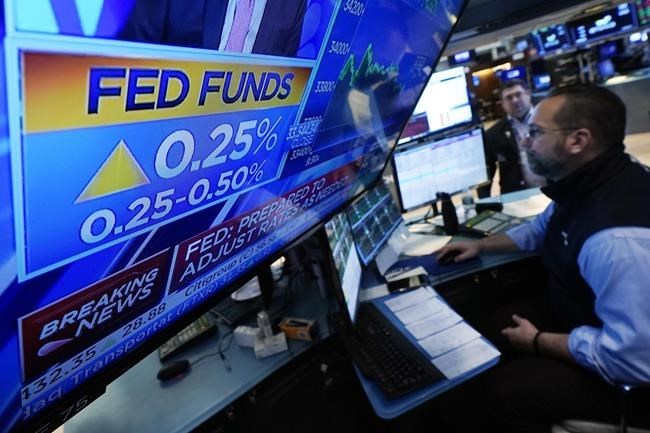TORONTO ŌĆö Talk of an upcoming recession is raising angst after a closely watched indicator flashed a warning sign, but experts say it could be a needed spark for investors to take a more active look at their portfolios.
Colin Cieszynski, chief market strategist at SIA Wealth Management, says investors should be ready, not complacent or passive, heading into an economic downturn.
"It's a little bit more of an active market for investors right now. It's the kind of time where you need to be paying attention and it's not necessarily good to just sit back and just pretend everything is fine."
Concerns about recession surfaced in recent weeks after inversions in the yield curve for U.S. bonds, a frequent indicator of an economic downturn.
An inversion occurs when the rate of short-term bonds exceed longer-term ones, which signals investors are concerned about long-term prospects for economic growth. In recent weeks,the five-year and 30-year bond rates inverted for the first time since 2006, followed by the two and 10-year bonds.
A persistent inversion of at least one month for the two and 10-year bonds in particular has historically been an early warning of a possible recession. The spread has a 70 to 85 per cent success rate in predicting recessions since 1980, says BMO deputy chief economist Michael Gregory.
The yield curve briefly inverted a couple of times last week for the first time since 2019. It remained inverted Monday but reversed course slightly a day later. By Thursday morning, the two-year rate was 2.453 per cent and the 10-year was 2.664 per cent.┬Ā
The 91įŁ┤┤ yield curve was not inverted.
Inversion of two and 10-year bonds is just one measure. A more accurate predictor of recession is an inversion of the three-month and 10-year bonds, says Jules Boudreau, an economist at Mackenzie Investments.
"And that's very far from inverting, so by looking only at the 10 minus two, which inverted for 15 seconds, we're kind of cherry-picking the indicator we want. So until we see the three month minus 10 year also invert, there's probably room to discount it a little bit."
While inversion may have been a reliable precursor to recession in the past, central bank quantitative easing policies to deal with the economic fallout from the COVID-19 pandemic may have reduced yields below where they would traditionally be, he says.
Boudreau says the economy is still pretty solid and not near a recessionary environment.
"We would motivate overweight in stocks or keeping an investment in stocks just because we think the economy is still pretty solid, even if we are seeing some parts of market signals announcing a possible recession."┬Ā
He says the probability of a recession is a little bit higher in the U.S. than in Canada.
"I would put the probability of recession still well below 20 per cent over the next few years at least in Canada," he says, noting that Canada has a buffer from high nominal GDP growth and very high commodity prices.
"Overall, I mean it's hard to forecast a recession when the economy is so strong."
The only way he sees a recession as likely is if central banks hike rates more than to the neutral rate and move above 2.5 per cent, which probably shouldn't happen until 2023.
"So we're definitely safe, at least for the next year," he says.
Craig Fehr, investment strategist at Edward Jones, agrees and says it's too early to overreact to a slightly inverted curve.
"We've seen the yield curve flatten dramatically many times in the past without producing a recession."
But for those anxious about the prospect of recession, it's a good opportunity to do some proactive portfolio rebalancing since a big movement in bond rates has probably thrown the equity-fixed income mix for a lot of investors off their long-term targets.
So, he says the first order of business for investors is to ensure they have sufficient fixed income to help weather elevated market volatility expected for the rest of the year.
"And then it's just about adding appropriate diversification to get that balance of growth and some protection against inflation, which equities, particularly high-quality equities, can provide that protection against inflation over time," he said.┬Ā
"The key is to make sure that as an investor, you're making some decisions that are better aligned to your time frame, as opposed to the time frame of the of the yield curve, which tends to be a more short term signal."
And it's important to avoid using selective indicators as an excuse to reduce market exposure, says Boudreau.
Diversification should be rule No. 1, he says, but next, concentrate exposure to stock markets with higher expected returns, like the 91įŁ┤┤ market, which is less sensitive to interest rate hikes.
"So I would say stay invested, but maybe tilt a little bit towards higher expected return markets like the 91įŁ┤┤ market and the TSX."
This report by The 91įŁ┤┤ Press was first published April 7, 2022.
Ross Marowits, The 91įŁ┤┤ Press



